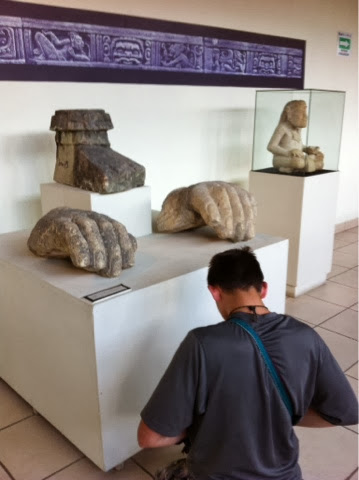After the first night in Copan Ruinas without a real window (just a screen) and we had to smell smoke from the neighbor burning stuff in his yard, Mom woke up with a really sore throat and coughing. So, we got to move to a really nice one. We had a pool, it was 4 blocks away from the hotel (: But it was nice.
These are macaws, very colorful birds that are by the ruins in Copan. They had a special relationship with the Maya, but have been overhunted for their feathers and for pets so they are endangered now.
That is, I think the largest temple in Copan is the hieroglyphic stairway which has 72 steps. This stairway contains over 2,500 glyphs and is the longest inscription found in North, Central and South America. It was built to give the history of past Mayan rulers. Most of the hieroglyphics are not in their original order because; in 1925, archeologists reconstructed the stairway and placed many of the stones in the wrong order.
Below is where they played "the ball game." Contestants used there hips, elbows, shoulders and knees, to try to hit a bird head (like in the picture at the middle-right) with a hard rubber ball made from the rubber tree. "Players would wear tree rings around their hips and throw an eight-pound rubber ball across the court without the use of their hands or feet. The captain of the winning or losing team, depending on the time period of the game, was then sacrificed on an altar in the Great plaza. They first cut off the player's head with an axe made of obsidian and removed his heart. The heart was then placed on top of the altar and the blood flowed down groves in the stone, to both the east and west. This was in accordance with the rising and setting of the sun. They then burned the heart so the smoke would reach the Gods in the heavens. The Mayans did this to insure good crops for the upcoming year. They believed, by killing their best player, he would be able to fight the ruling Gods of the underworld in honor of two ball playing heroes, the sun and the moon. This was true until the rule of 18 Rabbit. It is believed that during his rule he decided that it was not right to sacrifice the best player so he decided to sacrifice the loser of the game."
The tree below has roots above the ground that are at least 6 feet tall. It is called a Ceiba and is a sacred tree for the Mayan people...
These are two people from Germany that we shared a guide with. Their names are Constance and I cant remember his name. Anyway, they were really nice.
This is a depiction of the Mayan sun god emerging from the mouth of a jaguar. This is located in the ampitheator.
This is the head of what used to be one of the two largest statues in all of Copan. They believed the world was the back of a crocodile and this god and one other like it was holding the world up above a pond.
The ancient Mayan statues (at Copan at least) were carved in seperate peices and then assembled because they were so big.
I dont know what this flower is, do you?
This is the view from the deck of one of our hotels, the flat topped hill was a quarry - a source of stones for the Mayans to build Copán.
We went to the Macaw Mountin bird sanctuary and nature reserve. It was really spectacular, if you want to check out their project, Guaras en Libertad (Macaws in Freedom) go to the web site in the picture below.
This bird flew up to us when we walked up to the fence and went "hola." It was pretty cute.
This is for all the spider lovers, if you can see there is a 3 inch long spider in the middle of the picture.
Here is a picture of me with a macaw...
GUATEMALA CITY -
After Macaw Mountin we took a bus to Guatemala City to see museums.
These are the natural dyes and material that went into the origanal mayan clothing.
This is a piece of a mesoamerican throne.
This is a Mayan incense holder.This is a diorama of Tikal a few thousand years ago.
This is a Colonial Era painting from the 1750s depicting the Holy Trinity.
Had a great time heading and now we are heading to Tikal tomorrow at 4:30 AM tomorrow.Keep in touch on FB!


















































No comments:
Post a Comment